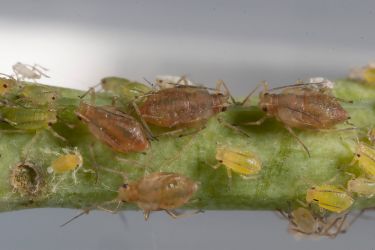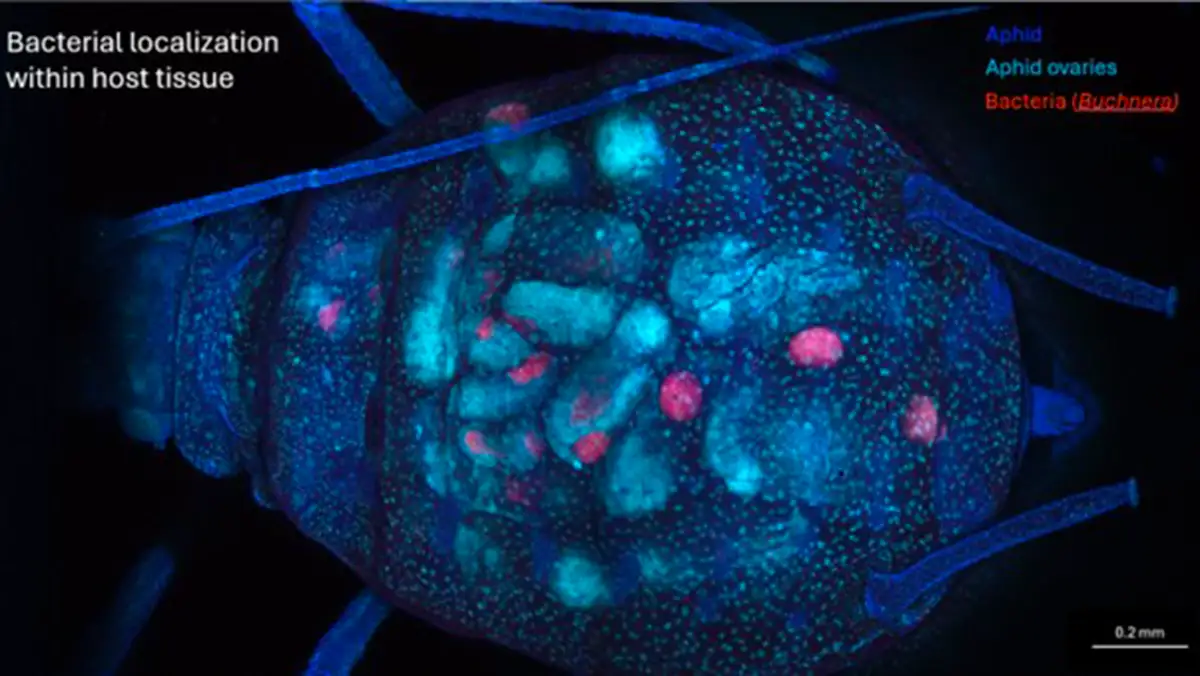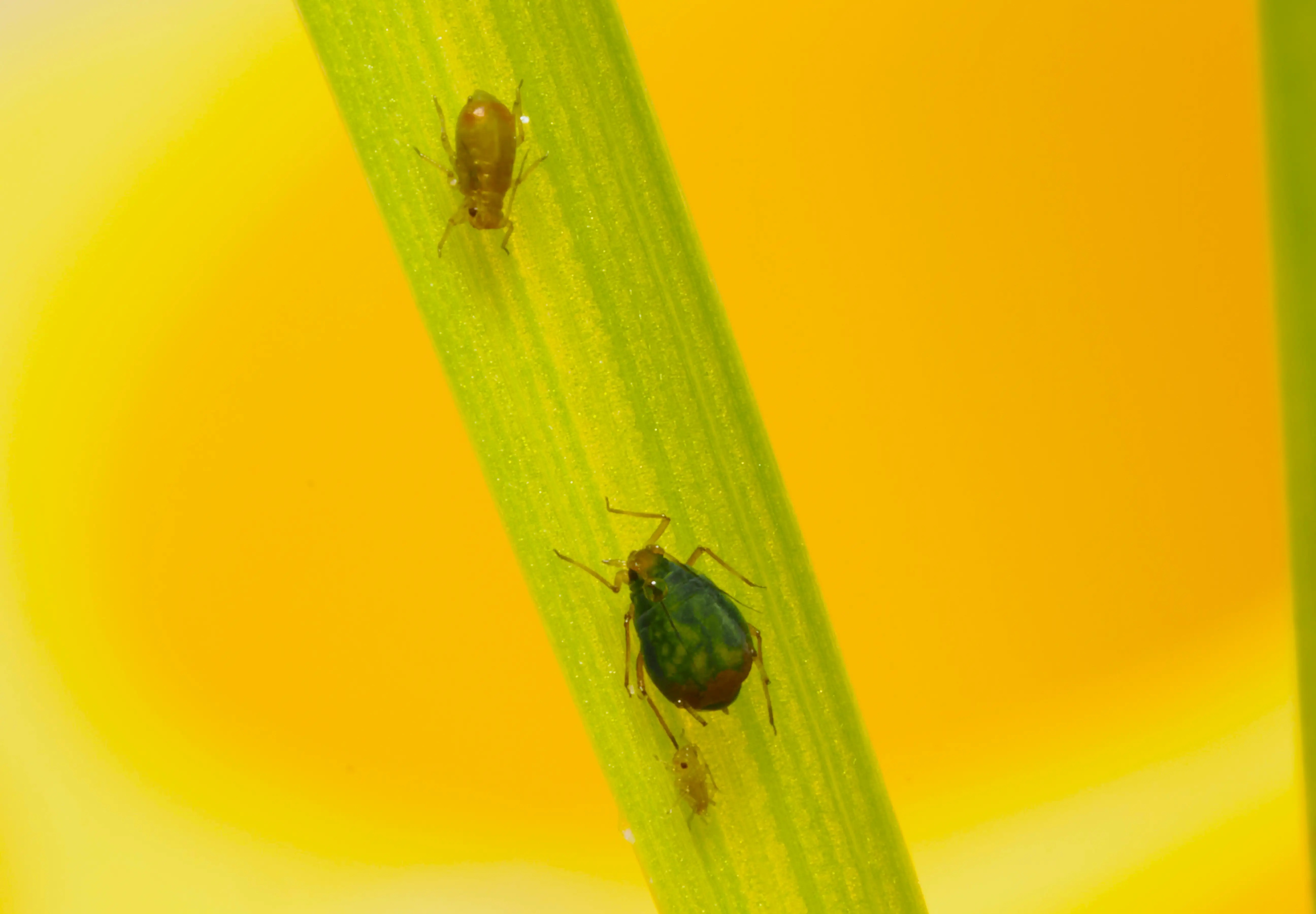
Sciences & Technology
Targeting the bacteria inside insects for improved pest management

New research into some of Australia’s most significant aphid pests is investigating their genetic resistance and microbes to develop sustainable pest control
Published 12 August 2025
Aphids. You might stumble across them in your backyard, snacking on your veggie patch, in fields and orchards where crops are grown and even along roadsides.
But this group of sap-sucking bugs are among the most economically damaging pest insects globally.

Two species, the green peach aphid and the oat aphid, are common pest aphids in Australia, affecting a wide range of crops – including grains, horticultural crops and ornamentals like cut flowers.
Australia has very few native aphids, but these invasive species not only cause direct damage but can also transmit over 100 different plant viruses.
And it’s this transmission that can lead to substantial yield losses and economic impacts.
Aphids are the main carrier (or vector) of major plant diseases like the Turnip yellows virus and the Barley yellow dwarf virus. Despite their names, the viruses are not exclusive to turnips or barley and can affect a range of crops and weeds.
The direct damage from the aphid, combined with the spread of viruses, can be devastating – causing yield losses up to 75 per cent.

Sciences & Technology
Targeting the bacteria inside insects for improved pest management
Most people are conscious of biosecurity risks because we know new exotic species can cause so much damage if they enter Australia.
There are some recent examples of biosecurity failures, including varroa mites that attack and feed on honeybees, and fire ants that can pose a danger to humans, livestock and wildlife.
But we’ve also had some new aphid pests enter the country and cause damage, including the Russian wheat aphid and the faba bean aphid.
However, new species of pests entering Australia shouldn’t be our only biosecurity concern.
There’s also the danger that new incursions of aphids already in the country can carry harmful hitchhikers.

One type of hitchhiker involves the genes that decrease the effectiveness of pesticides.
Aphids are well known for developing genetic resistance to pesticides. If new clones of aphid pests carrying resistance genes enter the country, this can make our existing pesticides ineffective.
There’s also another hitchhiker found in the bacteria and other microbes carried by aphids.
These can include new strains of viruses that cause diseases in plants. Or bacteria that make aphids less susceptible to the ways we try to control them.
Globally, there are growing environmental concerns around pesticide use that have led to a tightening of regulations around its use.

Sciences & Technology
Have resistance, will travel
Many agricultural industries are shifting towards the use of more sustainable control methods, which include preserving and releasing ‘parasitoid’ wasps.
These wasps lay their eggs inside an aphid, where the wasp larvae then feed on its internal tissues, eventually killing the host.
There are thousands of species of parasitoid wasps, and several species used on aphids are now reared commercially to control aphids.
These wasps can also act as natural protectors of crops and are becoming increasingly important biological control agents.
But the bacteria living inside aphids – called ‘symbionts’ – could jeopardise the effectiveness of the wasps.
Aphid symbionts live inside the organs and cells of aphids, evolving alongside them.
Some provide benefits to the host, while others act like parasites. The most common bacterium, Buchnera aphidicola, is found in almost all aphids and provides nutrients that aphids can’t easily get.
New approaches are targeting these symbionts to help reduce the impacts of aphids and other pests on plants. Some of these approaches also aim to affect the ability of aphids to transmit viral plant diseases.
However, other symbionts make it harder to control aphids with natural enemies like parasitoid wasps.
One particularly problematic bacterial symbiont is Hamiltonella, a microbe found in many aphid species that prevents the parasitoids from successfully controlling them.

Sciences & Technology
Scientists and government agencies are targeting mosquitoes with bacteria
In Australia, surveys by the Pest & Environmental Adaptation Research Group (PEARG) have discovered that, fortunately, aphids like the green peach aphids and oat aphids found here lack this bacterium.
But overseas, Hamiltonella can be found in many of our major pest aphid species.
While a few bacterial symbionts do occur in Australian aphids, these don’t seem to have had much impact on biological control with parasitoids and other natural enemies.
For example, in 2008 and in 2023, the symbiont Regiella was detected in green peach aphids locally, and there are instances of this bacterium providing parasitoid protection.
But, so far, it has remained rare.

A growing danger for Australia is new introductions of aphids harbouring Hamiltonella or other harmful symbionts from overseas, given that many are so common.
As Australia increasingly switches to biological control, these introductions could represent economic risks to industry.
So, it becomes more important to check for these microbes as well as other hitchhiking risks to pesticide resistance.
At the Pest & Environmental Adaptation Research Group, under the Australia Grains Horticulture Pest Innovation Program (AGHPIP), we are developing molecular methods to identify and understand symbionts and resistance genes in some of our most significant grain and horticultural aphid pests.

Sciences & Technology
Could Australia avoid egg shortages with better biosecurity?
We are also investigating how we can take advantage of bacterial symbionts to make pests less harmful, including modifying the bacteria they carry to reduce their ability to transmit viruses.
These kinds of controls could help to provide new directions in sustainable pest control and keep Australia protected from increasing insect threats.